If you are the type of snail owner who is carefully watching over his or her little zoo, then you probably already know that there are many different species in need of very specific foods in order to survive. Snails have a wide range of dietary needs, depending on the specific species of snail in question.
In this article, we will take a look at the various types of food that freshwater snails eat, as well as some of the nutritional benefits and drawbacks of each type. We will also provide a comprehensive guide to feeding your freshwater snail so that you can be sure that they get everything that they need.
Feeding Guide For Freshwater Snails
Feeding your pet aquarium snails is not as difficult as you may think. Here are a few general tips to help you get started:
Determine The Type Of Snail You Have
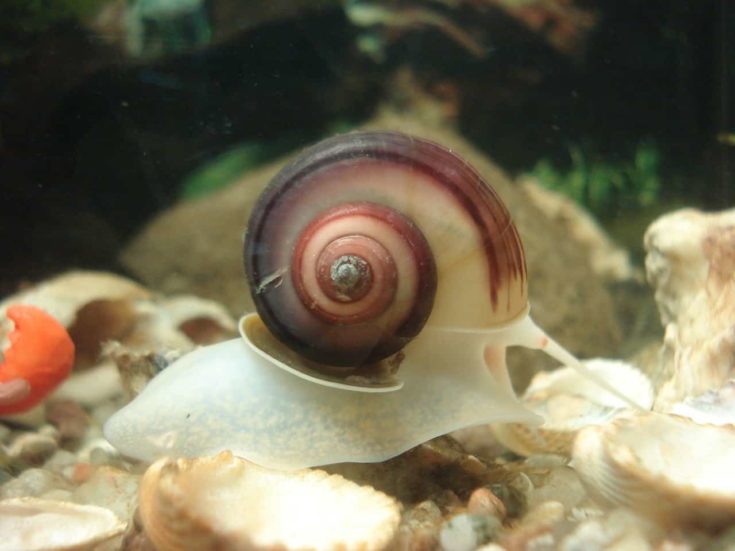
It may seem a little obvious, but before you start feeding your snails, it is important that you know what type of snail you have. Not many people realize that the various species of snails have very specific diets and nutritional needs!
There are three main types of freshwater snails-carnivorous, herbivorous, and omnivorous:
- Carnivorous aquarium snails typically eat other small animals, such as insects and worms. So, if your tank is home to cone snails, assassin snails, or a moon snail, then it will be necessary for you to feed these snails live foods, such as bloodworms or brine shrimp. This will need to continue throughout the life of the snail.
- Herbivorous snails are often found in ponds or other bodies of water that contain certain types of algae and plants. If you have types of snail that like to eat plants, such as nerite snails, then you can provide them with blanched vegetables or algae wafers as a food source.
- Omnivorous snails are the most common type of freshwater snail and they can eat both plants and animals. This means that you can provide them with a variety of different food sources in order to meet their nutritional needs. Some examples of omnivore snails include mystery snails, elephant snails, apple snails, and the ubiquitous mud snail.
Snails At Different Life Stages Have Different Nutritional Needs
Beyond just differentiating between snail types, it is important to realize that the nutritional needs of snails change as they grow and mature.
For example, newly-hatched baby water snails (those that have just been released from their snail eggs) must have a high-protein food source in order to survive. As they mature, you can slowly change their diet by increasing plant matter and reducing protein. On the other hand, adult aquarium snails do not need as much protein and can actually benefit from a diet that is high in fiber.
Snails in the middle of these two stages may need to have their diets adjusted accordingly. This is especially important for apple snails, which are known for being picky eaters in the early stages of development.
Variety Is The Key To A Complete Diet
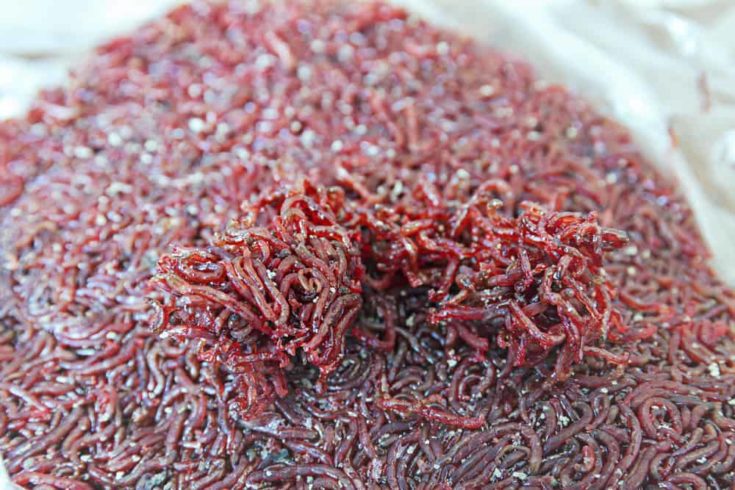
While it is true that most snails are able to survive on a diet of rotting plant matter, this type of diet will not provide them with the necessary nutrients that they need in order to thrive. Instead, you should be feeding your snails a wide variety of food, including both plant and animal material.
This can be accomplished in a number of ways. For example, you can feed your snail’s blanched vegetables or algae wafers one day, and then give them a bloodworm treat the next. You can also provide them with a variety of different types of foods from the list below.
What Do Freshwater Snails Eat?
Now that we’ve covered the basics of snail nutrition, let’s take a look at some of the specific types of food that freshwater snails eat:
Plant-Based Foods
Herbivorous snails and omnivores require plant-based foods in their diets. Here are some examples of plant-based foods that you can feed your snails:
Live Aquatic Plants
Many types of snails feed on live aquatic freshwater plants. Aquatic vegetation such as water hyacinth and water lettuce are often favorite foods for snails that are found in aquariums. Snails favor these types of plants as they are a good source of both nutrients and moisture.
Though many fish keepers lament the way snails eat live plants, it is important to remember that snails generally prefer dead or decaying plant matter. Freshwater snails in an aquarium will be able to quickly reduce the number of live plants in your tank, but will not cause lasting damage. If you have delicate plants in your tank, it is best to remove the snails instead. Plant choices matter, especially in a snail tank!
Of course, some aquarists might want to feed their snails with live plants. A popular way of doing so is by using the leaves of stem plants. In doing so, be sure to only use those that are safe for snails to eat. Some plants, such as the lily family, are toxic to snails and can cause them to die. And of course, you should only introduce healthy plants that are free of pests and diseases.
Dead Plant Matter
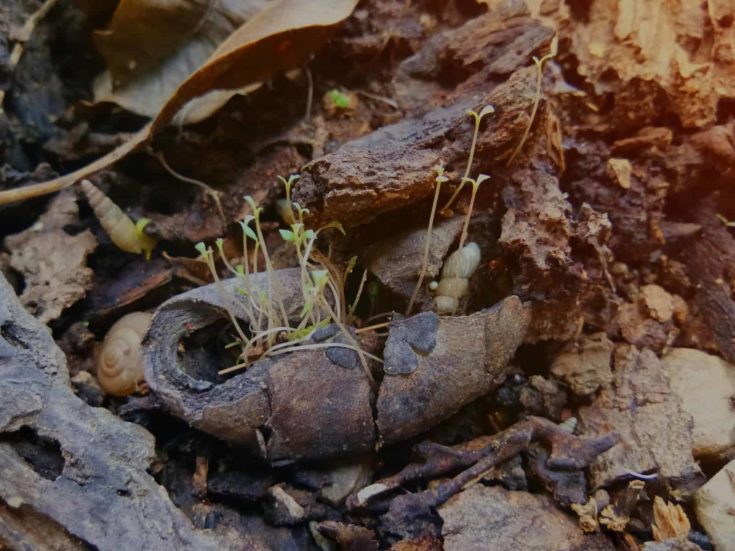
Dead plants in the aquarium offer snail a source of food that is not only nutritious but also easy to access. This type of food might include leaves or blooms that have fallen off live plants in your tank. Left uneaten, these decaying plants can create an unhealthy environment in your aquarium by providing a breeding ground for bacteria.
It is important to keep a close eye on the amount of decayed plant matter in your tank, as too much can lead to problems such as algae blooms. If you do find that your tank has become overgrown with rotten plant matter, you can siphon it out using a gravel vacuum. You should also attempt to investigate what’s causing your plant life to die so that you can address the problem.
Aquarium plants can be a great food source for snails, regardless of whether they are live or dead. Just be sure to only use healthy plants that are free of pests and diseases.
Tree Bark
We can hear your snails screaming “tree bark?” already. But yes, some freshwater snails are known to eat the bark of trees. In many cases, tree bark makes up a large part of the snail’s diet, or a typical diet for pond snails. It is a good source of food for them, as it is both high in fiber and low in protein.
If you have a pet snail that is known to eat tree bark, you can provide this type of food by either leaving a piece of wood in your tank or attaching something like a chunk of cork to the side of your aquarium. This type of bark might include mulberry tree bark, which is a favorite of apple snails, or oak tree bark, which is a favorite for ramshorn and Malaysian trumpet snail.
In some cases, the bark might be supplemented with leaves from other types of vegetation. Berry leaves, for example, are known to be a favorite treat of ramshorn snails. Just be sure to avoid leaves from poisonous plants, as they can be harmful to your snails.
Fruits
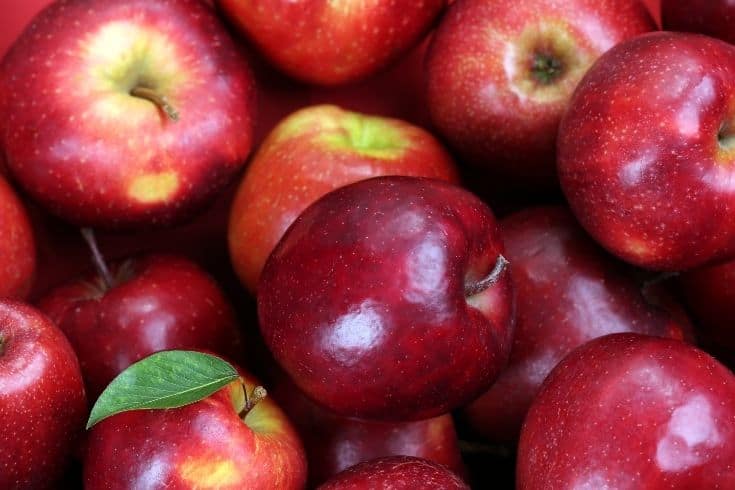
Aquatic snails are not just limited to a diet of plant life. In fact, many types of snails enjoy eating Fruits. This type of food is beneficial to them as it helps to keep their digestive system functioning properly. The natural food cycle for a snail includes both plant and fruit matter.
If you would like to provide your snails with acidic fruits, you can do so by either dropping a piece of fruit into your tank or attaching it to the side of your aquarium with some twine. Some popular types of fruits that snails enjoy eating include:
- Apple
- Kiwi
- Banana
- Papaya
One thing to note is that you should avoid feeding your snails acidic fruits, as they contain citric acid. This type of acid can be harmful to the snails and might even kill them. So, steer clear of oranges, tomatoes, and other acidic fruits when feeding your snails. As is the case with live plants, fruits will eventually decay in an aquarium, so be sure to remove them before it has a chance to do so!
Algae
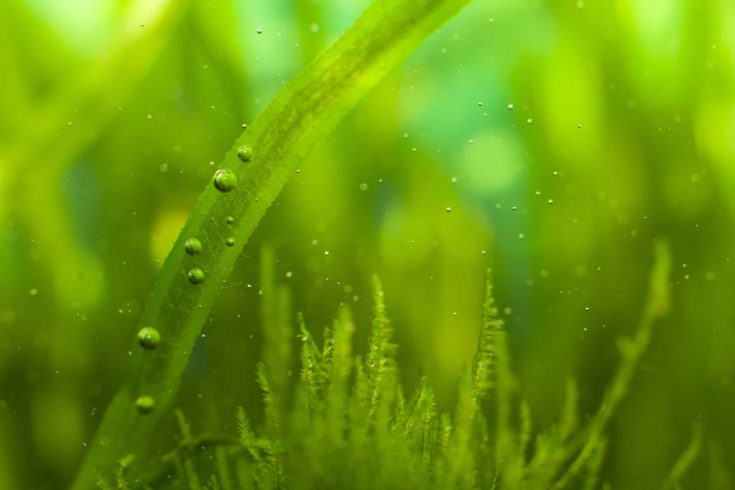
Providing your snail with a steady supply of algae to eat is a great way to ensure that they stay healthy and happy. Algae can be found in both fresh and saltwater, making it an easy food source for snails. Freshwater-dwelling snails enjoy many different kinds of algae, including microscopic algae, or soft algae such as hair algae.
You can provide your snail with a source of algae by either dropping a piece of algae into your tank or attaching it to the side of your aquarium with some twine. If you have an abundance of algae in your tank, you might not need to supplement their diet with algae tablets. Microbe colonies will also often form on the sides of an aquarium, providing a natural food source for your snails.
In general, herbivore snails and omnivorous snails will eat algae as their primary food source. There are even some types of freshwater snails that primarily rely on algae as their sole source of nutrition! On the other hand, carnivorous snails rarely eat algae and will often starve if they don’t have access to meatier foods. Be sure to research the dietary habits of your specific snail to determine if algae is an important part of their diet.
Animal Protein
Carnivores and omnivores need animal protein to survive, and this is where our list comes into play. Here are some nutritious sources of animal protein that your snails are sure to love:
Dead Animal Matter
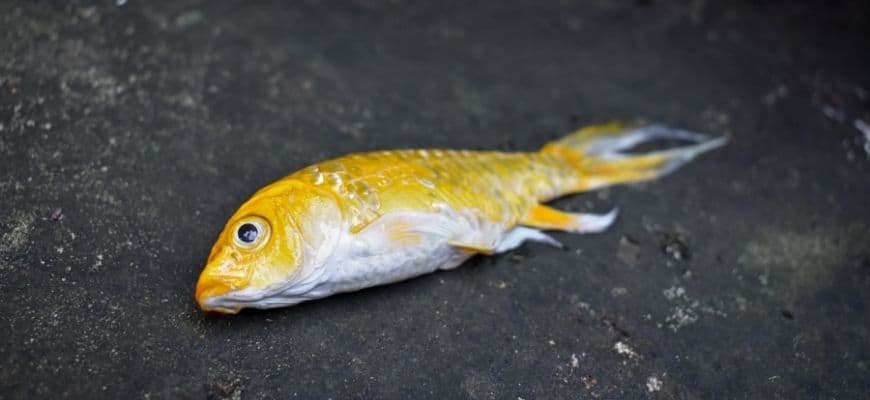
If you’ve ever heard of detrivores snails, then you might already know that some species of snails enjoy consuming a diet of dead animal matter. In fact, detrivore aquatic snails are quite popular with fish hobbyists!
There are a few different ways to provide your snail with dead animal matter. One way is to leave animal carrion or a dead fish in your aquarium for several days or weeks. Just be sure to test water quality before doing so, as some decaying animal matter can release toxins into your tank, or foul your water quality.
As is the case with any kind of decaying organic matter, dead animal matter can smell horrible. If you are not able to handle the smell of dead tissues, I wouldn’t recommend providing your snail with a diet that includes it! Let’s take look at some other meat-based options below.
Shrimp-Based Protein
Brine shrimps make a great food source of protein for water snails, as they are packed with nutrients that snails find beneficial. The fact that shrimp are also aquatic creatures means that they are easy for snails to digest. You can also choose to grow your own brine shrimp using brine shrimp eggs, if you want to go the extra mile!
When feeding your snails brine shrimp, you should drop it into the tank so that they can find it easily. Just be sure to provide only as much shrimp as your snail can eat within a few minutes, otherwise it might go bad before your snail has had a chance to eat it. You can tell if a shrimp has gone bad by its smell, so be sure to monitor your snail’s food closely.
Another thing to note is that brine shrimp do not have a very long shelf life, so you should only purchase what you need for the week. If you have any leftovers, I recommend throwing them away so they don’t go bad in your fish tank. You can also opt for shrimp pellets as a protein-rich food source for your snails.
Feeder Snails
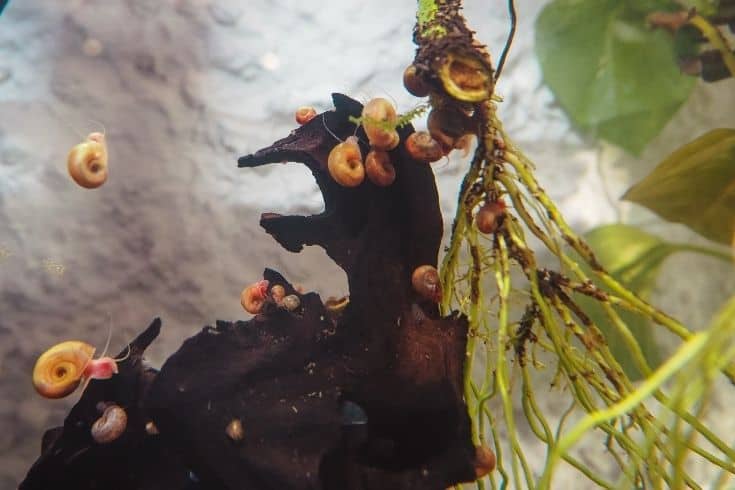
Macabre as it may seem, some snail enthusiasts like to provide their carnivore snails with live diets of freshwater snails. This can be a great way to provide your snail with a balanced diet, as feeder snails are packed with nutrients.
You can find feeder snails in many specialized pet stores, though we highly recommend doing your research to locate a trustworthy source for snails if you are considering this option. This is because there have been cases of parasites being transferred from feeder snails to pet snails, so it is important to take precautions.
In addition, you can also opt for freeze-dried snails, which you can feed to your snail as a supplemental food source. This is a great option if you have an excess of snails in your aquarium, or if you have trouble with feeder snail infestations. Do note that an exclusive diet of pond snails can lead to deficiencies in your pet snail, so it is important to vary their diet as much as possible.
Aquatic Snail Food
Last but not least, you can also opt to feed your pet snail with an aquatic snail food. Commercial snail mixes make a solid choice for freshwater snails because they are packed with the right kind of nutrients- including algae!
There are different variations of snail food on the market, so I recommend doing some research to find one that fits the dietary needs of your specific snail. For instance, carnivorous snails will require a different type of food compared to herbivorous snails. Baby snail food is also available, and can be a great way to introduce young snails to the diet they will need as adults.
Just like brine shrimp, aquatic snail food should be dropped into your aquarium so that your snails can find it easily. In addition, because this type of food is designed for snails, it will sink to the bottom of your tank and stay there, making it easy for your snail to find.
Commonly-Asked Questions About Snails
Can We Feed Snails With Leftover Fish Food?
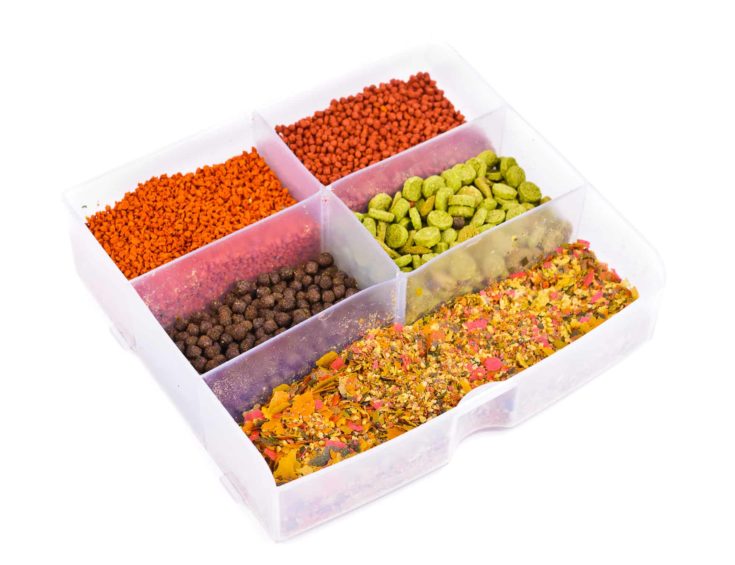
In general, we don’t recommend feeding snails with fish food.
While you can feed your snail with bits of fish food, it is not the best option for their diet. Fish food is designed to meet the dietary needs of fish, not snails. In addition, fish food can often be high in phosphorus and nitrogen, which can be harmful to snails.
If you do choose to provide your snail with fish food, it is important to only offer them a very small amount. The leftovers of fish food can lead to fouling of your aquarium water and overgrowth of algae.
Do Snails Require Calcium Supplements?
Calcium supplements may help, but are usually not necessary.
In general, snails rely on the calcium carbonate in their environment as their primary source of calcium. This means that they will get the majority of the calcium they need from the water and substrate in your aquarium. If you are concerned that your snail is not getting enough calcium in their diet, you can try supplementing their regular food with a calcium-rich food source.
However, if you notice that your snail’s shell is beginning to dissolve or is brittle, you should stop supplementing their diet and consult a veterinarian as soon as possible.
What Kind Of Water Do Freshwater Snails Need?
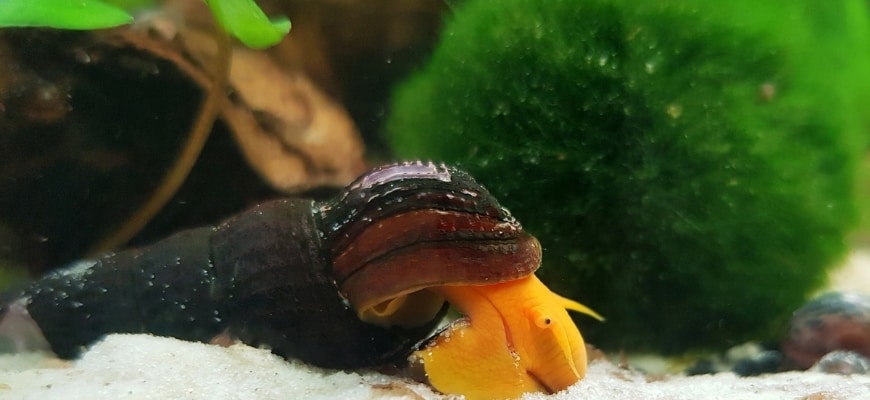
While freshwater snails are highly resilient, their water does need to be clean to remain healthy.
Freshwater snails do not drink water like fish, but absorb it through the pores on their body (similar to how amphibians breathe). Because of this, they need dechlorinated water to stay healthy. Chlorine can be harmful to their delicate skin, and can even lead to death.
In addition, snails also need water that is low in sulfates and nitrates. High levels of these compounds can be toxic to snails and can cause them to suffer from health problems. pH levels should be kept around 6.5 for snails, or slightly acidic.
Can Snails Have Tank Mates?
Of course!
One of the great things about keeping freshwater snails is that they can be kept in community tanks with other fish and invertebrates. In fact, many people keep snails as pets specifically because they are such low-maintenance creatures.
Just make sure that you do your research and select tank mates that will be compatible with your snail. For instance, some snails are known to be aggressive with other similar species. Some invertebrates can also prey on freshwater snails.
Conclusion
We hope that you enjoyed this article on what freshwater snails eat! We tried to be as thorough as possible and answer all of the most commonly asked questions. If you still have questions, feel free to ask them in the comments section below. And if you know someone who is thinking about getting a freshwater snail, please share this article with them!
